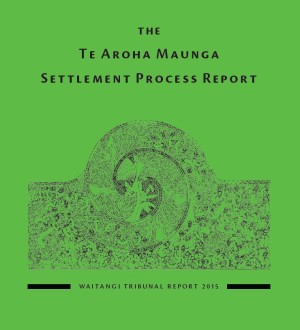The Te Aroha Maunga Settlement Process Report released

The Waitangi Tribunal has today released the final version of its Te Aroha Maunga Settlement Process Report. The report is the result of an urgent inquiry into an aspect of the Treaty settlement process in the Hauraki district. The Waitangi Tribunal had previously found, in 2006, that groups in the Hauraki district have well-founded claims concerning past Crown actions. The 12 iwi in the Hauraki district then formed the Hauraki Collective and entered into negotiations with the Crown in 2010 for the settlement of their claims. However, one of those iwi, Ngāti Rāhiri Tumutumu, has raised serious concerns about Crown actions in the settlement negotiations. In February 2014, the Tribunal declined Ngāti Rāhiri Tumutumu’s application for an urgent remedy of the situation, but it granted an inquiry into an aspect of the negotiation process. An urgent hearing took place on 7 and 8 May in Wellington before a panel consisting of Judge Michael Doogan (presiding), Dr Rawinia Higgins, and Professor Sir Hirini Mead.
The inquiry focused on whether or not the Crown had dealt fairly with a conflict between Ngāti Rāhiri Tumutumu and the Hauraki Collective over the return of land on Te Aroha maunga. Te Aroha and Moehau maunga are iconic to all Hauraki iwi. The Crown has offered to the Hauraki Collective the fee simple return of 1,000 hectares on both maunga. Te Aroha maunga is central to Ngāti Rāhiri Tumutumu’s claims. While they will share in the Hauraki Collective vesting, they also wanted land on Te Aroha vested in themselves, including all or part of the land on offer to the Collective.
The Tribunal has found that the process by which the offer of land on Te Aroha maunga was made to the Hauraki Collective was not unfair to Ngāti Rāhiri Tumutumu, nor was it in breach of the principles of the Treaty of Waitangi. In coming to that view, a significant factor was Ngāti Rāhiri Tumutumu’s support for the process that led to the offer. That process, the Tribunal found, generated significant early momentum in the Hauraki negotiations, from which Ngāti Rāhiri Tumutumu and the other iwi of the Hauraki Collective benefited.
The Tribunal found that factors leading to this inquiry stemmed partly from what appeared to be irreconcilable differences between the redress offered to the Hauraki Collective and the aspirations for redress of Ngāti Rāhiri Tumutumu. The Tribunal also identified as contributing factors a lack of clarity concerning both how each iwi's interests would be negotiated and recognised within the context of collective redress and, in that context, what the respective roles and responsibilities of the Crown and the Collective were.
While the Tribunal did not make a finding of Treaty breach and therefore made no recommendations, it did express unease with the situation that Ngāti Rāhiri Tumutumu were in, noting that the Hauraki Collective’s redress was being finalised in circumstances where it was unclear how Ngāti Rāhiri Tumumu’s core claim would be addressed. The Tribunal therefore made some suggestions in the report that it hoped would assist all the parties.
The Tribunal observed that, in negotiating the return of close to 1,500 hectares on Te Aroha, Ngāti Rāhiri Tumumu and the Hauraki Collective have achieved a great deal in their negotiations with the Crown. It concluded that ‘there can and should be opportunities for collaboration over governance of the collectively owned parts of Te Aroha and those areas that are to be returned as iwi-specific redress to Ngāti Rāhiri Tumutumu’.
Read Te Aroha Maunga Settlement Process Report [PDF, 2.8 MB]
For media inquiries, contact the Ministry of Justice media centre.(external link)